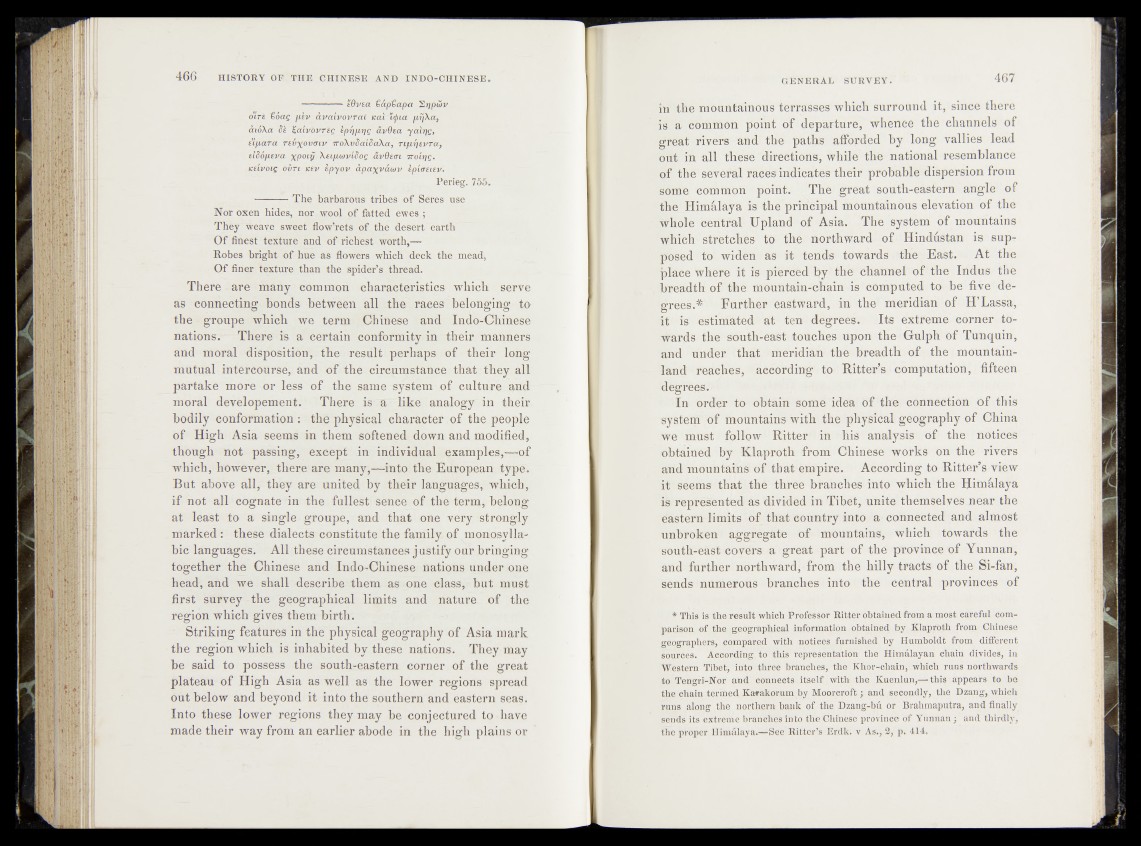
-------- Idvta €dp€apa Sijpwv
- oïrs tóttg plv avaivovrat tcal itpia p^Xa,
dióXa Sk %aivbvTBQ IpijprjQ avdea yalrjg,
> ettfidra TÉ{i)(ovftivi'iroXvêdtëaXdj Tiprjsvra,
eiêó/teva XPmV Xet/juaviëog &vQs<rt ttowiq.
-KitiVOig. ó-iiri ksv kpyov &pa%va<ap Ipiaiiev. *
_ Perieg. 755.
f -------- The, barbarous tribes of Seres use
Nor oxen hides, nor wool of fatted ewes ;
. They Weave sweet flow’rets of the desert earth ~
Of Mest texture and of- richest worth,—
Robes bright of hue as flowers which deck the, mead,
Of finer texture than the spider’s thread.
There - are many common characteristics which serve
as connecting bonds between , all the races^belonging- to
the group© which we term Chinese and Indo-Cldnes|i*
nations. There is a certain conformity in their manners
and moral disposition, the result perhaps?,rof thei^ykmg
mutual intercourse, and of the. circumstanceithat they all
partake more or less of the same system-of culture and
moral developement. There is~av like analogy\dn their
bodily conformation : the physical character. of the people
of High Asia seems in them softened?down and modified,
though not passing, except in individual examples,—of
which, however, there1 are many;—rinto the European type.
But above all, they are united by their languages, which,
if not all cognate in the fullest sence of the term, belong
at least to a single groupe, and that one very'strongly
marked: these dialects constitute the family of monosyllabic
languages. All these circumstances j ustify our bringing
together the Chinese and Indo-Chinese nations under ene
head, and we shall describe them as one class, but must
first survey the geographical limits and nature of the
region which gives them birth.
Striking features in the physical geography of Asia mark
the region which is inhabited by these nations. They may
be said to possess the south-eastern corner of the great
plateau of High Asia as well as the lower regions spread
out below and beyond it into the southern and eastern seas.
Into these lower regions they may be conjectured to «have
made their way from an earlier abode in the high plains or
in the mountainoub^ë'ffira'ssês’which surround it, since there
fil a ëénmon jjoint of depflftu're, whence the channels of
^fêöt^ri^^^an|fefe pathos' "afforded by long yallies lead
out in all ^ ^ ^ ^ irec tiu n s, while the national resemblance
^fphkwvéfil fêfê$#indicatSl§ttheir probablefdispersion from
^ ebi’c comil^n The >g^öaittp°uth-eàstern angle of
thb; Himalaya is thê^prmMpal w|&utainous élévation of the
whol&^èentral- Bjlapd of Asml Thê||y^%p óf moühtains
which sèrei(^®^ tö the nöEthward 6^ Hindustan is supr
ïpfosed to widën as it«’tends towards v-the^ifiast,^. At thg|
pluce wherë it is pierifed- ^y^thfe? channelled* the Md’tföfthe
breadth of thé mountainJcÉlain is^ê’fmputed t<# be five
prées.:#'- Further^ea^i#-atd, « in the meridian o f-H’Lassa,
it « is*^ estimated at Its dxtèém.e corner towards
the^ëôuth-e^tiîtoUches'fnpon th e ^ il^ f ^ T u n q u in ,
and under that meridian* «tif^.breadth of the mountain-
land «^according to Ritter’s computation, fifteen
e*In order fi^obtain some ’idea* bf the; connection of this
^systenr^df mou#tàihs withbwerfphystèàli^Éègfaphy of China
jwe must follow Ritter^« in « hi44 analysisof the nUtfëëfe
obtained by Klaproth from Chinës’è works on thë/^rivers
and mountains of that Empire; • According*iio Ritt^s-view
i t 1 seems that the three branches* into which the Himalaya
is reprësented as dividèdûn Tibet, unite-thômselves néàr the
eastern limits of that cotfetry into a* doSinected muh almost
unbroken aggregate of ‘'mountain#, which towards the
#buth-east covers a great *paHkof the province'of Yunnan,
and further northward, «from the' hilly tracts of thS^Si-fan,
sends numerous branches-into ‘ the ; cêùtral provinces ’ of
* This is the result whip^Professor Ritter obtained from a. most careful comparison
of the geographical information obtained by dpaprbth from? .Chinese
geographers, pompared with notiees^furnished by Humboldt from different
sources. According 'to this représentation the Himalayan chain abides, in
Western Tibet, into three branches, th& Khor-chairi;1 which runs northwards
to Tepgri-Nor and connects. itself with the .Kuenlûn,^'this appeals to be
the chain terßied Ka#akorum.by Moorcroft ; andjseqondly, the Dzang, wifleh
runs .along the northern hank of the Dzang-bu. or.-Brahmaputra, and finally
sends its extreme branches into the Chinese province of Yunnan ; and thirdly,
the proper Himalaya.—-See Ritter’s Erdk. v As., 2, p. 414.